Entering Brunei was a mission almost larger than the country itself. Although it has a free attitude to visas, the was a markedly different opinion about H1N1 and bringing in Bibles or alcohol. After dancing in front of a body heat camera and emptying our bags completely, Hyun and I entered the small Islamic sultanate with a view to spending a single night in the capital, Bandar Seri Begawan.
Brunei has close links with the UK, not least because it is surrounded completely by Sarawak, and indeed is divided in two by that state, courtesy of Charles Brooke, the second White Rajah. In 1847 a treaty of friendship and commerce was signed between Britain and Brunei, and the sultan agreed not to cede any more territory to anyone, without British permission first. However, this did not stop Charles Brooke seizing Limbang and dividing Brunei in two - this despite the fact that Brunei had been a British protectorate since 1888.
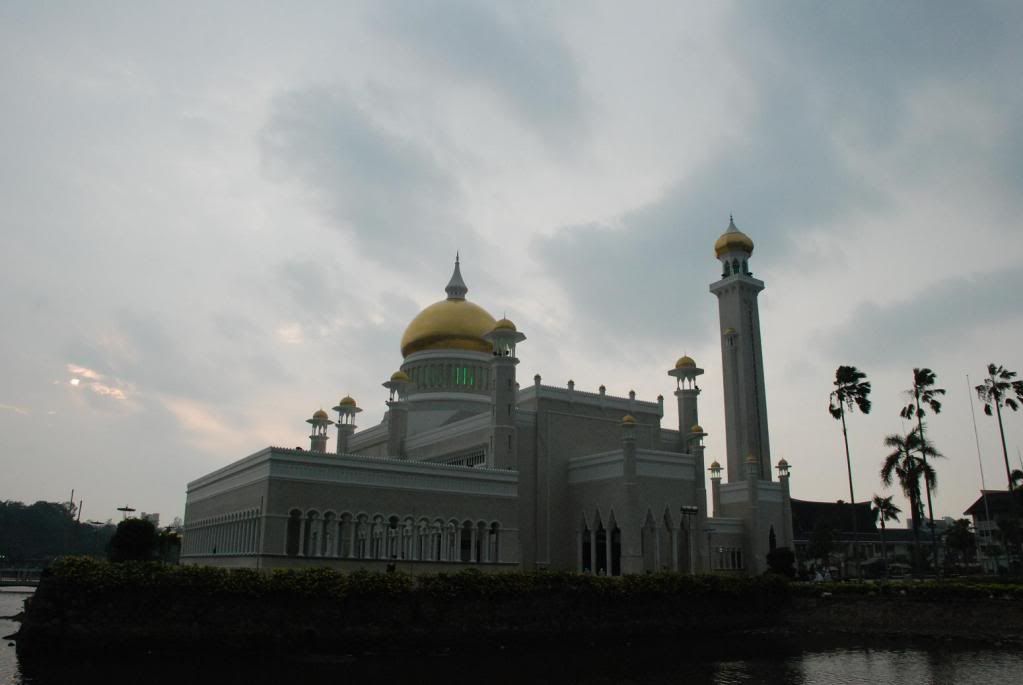
The BIG mosque in Bandar's centre
Shortly after WW2, the UK found itself with the new colony of Sarawak just as it was losing most of the rest - the third White Rajah Charles Vyner Brooke decided it was in Sarawak's best interests. Brunei developed a fairly healthy paranoia about the threat posed by neighbouring Sarawak, Sabah and Kalimantan, and it was only when treaties were signed guaranteeing it's independence did formal protection of the Sultanate cease.

The BIG mosque in Bandar's centre
Shortly after WW2, the UK found itself with the new colony of Sarawak just as it was losing most of the rest - the third White Rajah Charles Vyner Brooke decided it was in Sarawak's best interests. Brunei developed a fairly healthy paranoia about the threat posed by neighbouring Sarawak, Sabah and Kalimantan, and it was only when treaties were signed guaranteeing it's independence did formal protection of the Sultanate cease.
The tortuous journey to our hotel in the capital involved several different buses and a tour of most of Brunei's developed coastal strip. With only a small amount of it's original territory left, Brunei found it still owned, by happy accident, the largest oil and gas reserves off Borneo's coast. These were centred around Seria, where a regiment of Gurkhas is still garrisoned (and from where the British Army still conducts it's jungle training). Seria was a proper oil town - nodding donkeys were present on most street corners and Shell sponsored almost all the development.
We arrived in Bandar at around 3pm, and after settling in a hotel, headed to the city centre to look around. Brunei is massively rich state whose citizens pay no tax, and where cars and houses are subsidised. We wanted to look around the Kampong Ayer or water village - an entire town built on stilts over the river that runs through the capital. Usual transport was by speedboat, and we opted for a quick tour in one of these "flying coffins" as a thunderstorm approached. Sadly the rain arrived much sooner than expected and we spent 20 minutes moored under someone's house, before getting drenched heading back to dry land.

Kampong Ayer as the storm comes
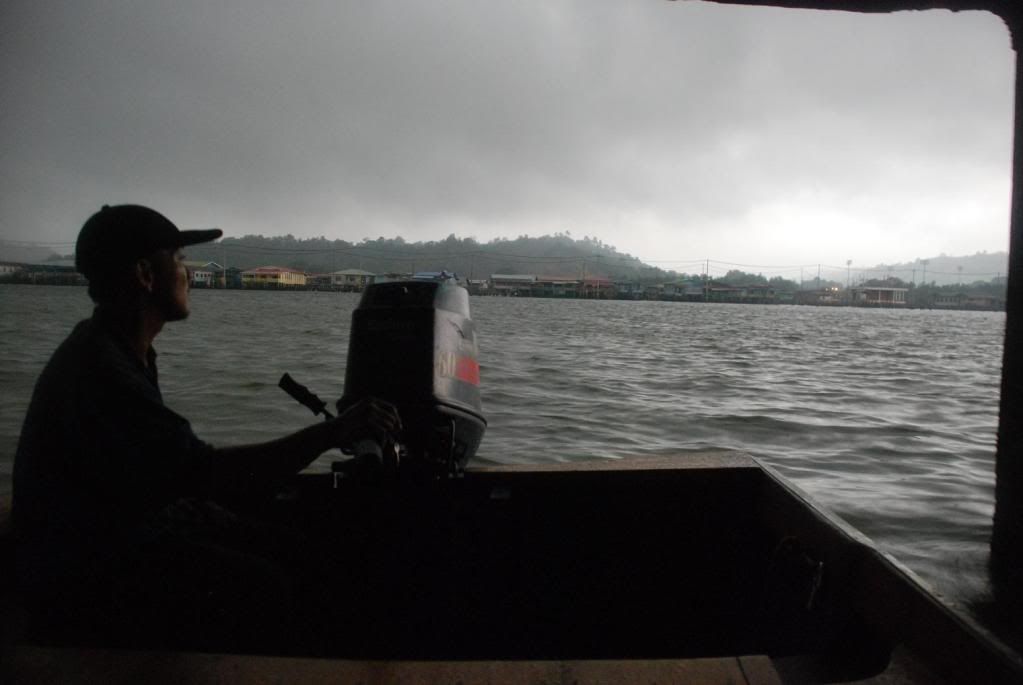
Waiting for the rain to stop
Brunei didn't blow us away, although I suspect with more time we would have found the Royal Regali museum pretty smart and the Empire Hotel on the coast pretty impressive - rivaling Dubai's finest for opulence. Instead we cruised over to the night market for food in the pouring rain - it was a tad washed out - and spent an hour or two wandering around shopping malls before calling it a night.
The following day we transferred east to Kota Kinabalu, in the Malaysian state of Sabah. Luckily our taxi driver to the ferry was more alert than we were, and smashed the speed limit in order to get us to the jetty in time for departure, 30 minutes earlier than we had been informed. We left Brunei with $2 to our names and a good deal of nervous laughter - Hyun was on a flight that afternoon from KK and missing the boat was not an option.
Kota Kinabalu - formerly Jessleton - is the capital of Sabah, which was formerly British North Borneo. Originally ceded ro the American consul in Brunei in 1846, the subsequent attempt to operate the American Trading Company of Borneo failed after 20 years, whereupon Dutch and English investors were convinced to take up the deal. Eventually in 1877 the cession was bought and extended to cover the present day area of Sabah, and 3 years later a royal charter was granted and the British North Borneo Company - and British North Borneo - was formed; the Dutch were booted out of the deal.
Kota Kinabalu - or KK - is a modern city with a thriving fishing, logging and tourism industry. It serves as the entry hub for legions of tourists arriving every year who want to experience the magic of Borneo without the difficulties of travel in less developed countries. We had been hearing stories of many of the most popular activities being booked up weeks in advance, and so I arrived with a pretty concrete plan of action for my two and a half week stay.
After saying goodbye to Hyun I set about booked and paying for my various trips - aside from the organisation required, many tourist attractions on Sabah are expensive and several well beyond the means of even the wealthiest of backpackers - the allegedly amazing National Parks of Tabin and Danum Valley cost well over US$100 per night. So I signed up for a rafting trip, booked my Mount Kinabalu climb, arranged some diving and a river safari - all within a couple of days. At least I wouldn't spent too much otherwise, I thought.....
The El Nino-inspired drought that has affected much of Borneo had taken it's toll on the river rafting. We took Sabah's only train to reach the access point - it was full so we rode on a flat iron car at the back, legs dangling over the edge and getting sunburnt. Health and Safety would have raised the odd eyebrow. After a remarkably thorough safety briefing I joined an all-Dutch raft to navigate our way down what should have been Grade III-IV rapids to lunch.
It was great fun, but a little disappointing. The rapids weren't huge, but it seemed like most of the time I was the only person who knew how to paddle and by lunch my shoulders and arms had had a good work out at least. We watched the video footage of our most exciting rapid over lunch - one of our team was washed out when we became perched on a rock - then pressed on quickly as we were running very late. It was a case of catching the train back to get a bus for the return - this time we had the privilege of seats. I was back in KK at 10pm that night, aching but happy... and a little burnt.
The next day I moved out of KK and up to Mount Kinabalu National Park- popularly known as South East Asia's highest peak at 4095m - that works if you don't include any of New Guinea in the equation, which has a couple over 5000m. Geographers might care to explain if SE Asia doesn't include New Guinea..... Given my past experience with nausea and headaches at that kind of altitude, I stayed a night close to the Park Headquarters, meeting a seemingly alcoholic American called Diego en route with his lovely Japanese girlfriend who didn't speak much English. Given Diego's passion for TV, it turned out to be a quiet night when he found we had HBO in the dorm room. In the morning, however, there was a tremendous view of Kinabalu in the early morning sun that made the stay well worth the effort.
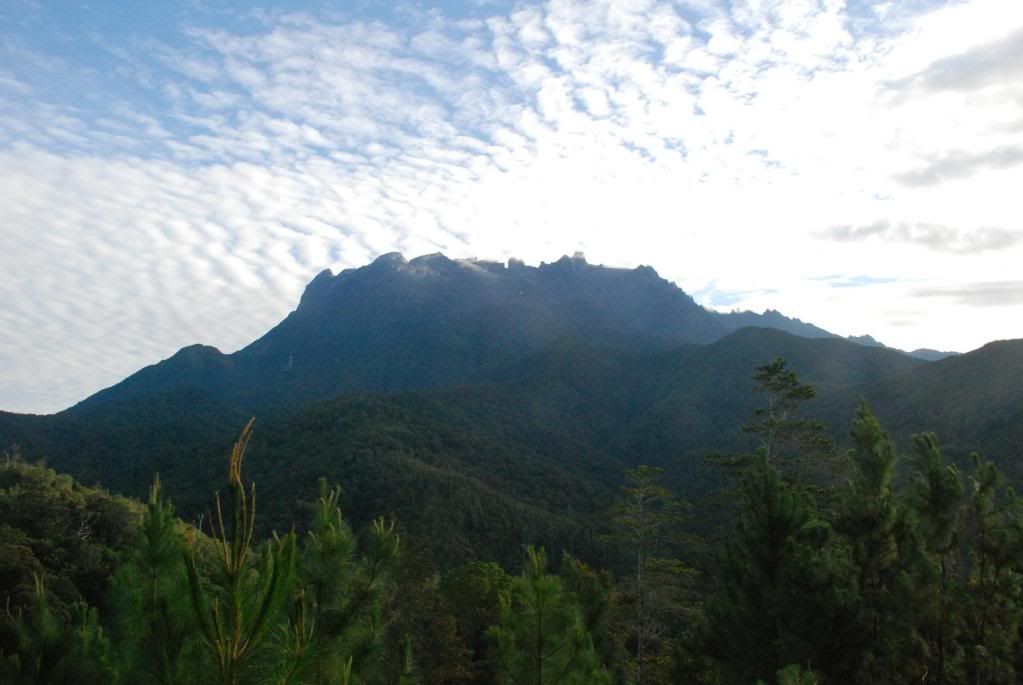
The next morning was the day I had booked to start my trek to the summit of Kinabalu. The National Park is privately run by a luxury lodge company, Sutera Sancturary, who fail to appreciate that most of the customers are backpackers - it was some GBP80 for an unheated dormitory bed plus food for the following 30 hours - and that didn't include the compulsory guide and a few other extras. Luckily I met up with a couple of Irish girls and an English couple and we banded together to share costs and form a little hiking team.
The first day's hike was a long, tedious uphill slog that sapped strength and enthusiasm. For much of the time we were in fog and cloud, and were wary of the rain that was forecast to start - along with thunder and lightning - at any time. We made it up to the Laban Rata guesthouse after about 4 and a half hours, and were just sitting down with hot chocolates as the rain started to fall, progressing to hail shortly afterwards.

Laban Rata after the rain

Sunset at Laban Rata
What Sutera Sanctuary fail for in accommodation they try to make up for with food - there was oodles of it. Having gorged myself on a high carbohydrate dinner I settled in bed with a makeshift hot water bottle and tried to get in a few hours sleep before our summit day, which would start at 1.30am.

At a time that could officially be called silly-o'clock I woke up and had another carb-loaded early breakfast, before starting the slow walk up to the summit in the dark, along with about 200 other people. The route had many stairs and roped sections, and unsurprisingly progress was very slow as people struggled in the thin air and dark. Nevertheless we made it to the summit in time for sunrise, and everyone stopped to take photos as their fingers froze and feet went numb. The summit was a very crowded place.
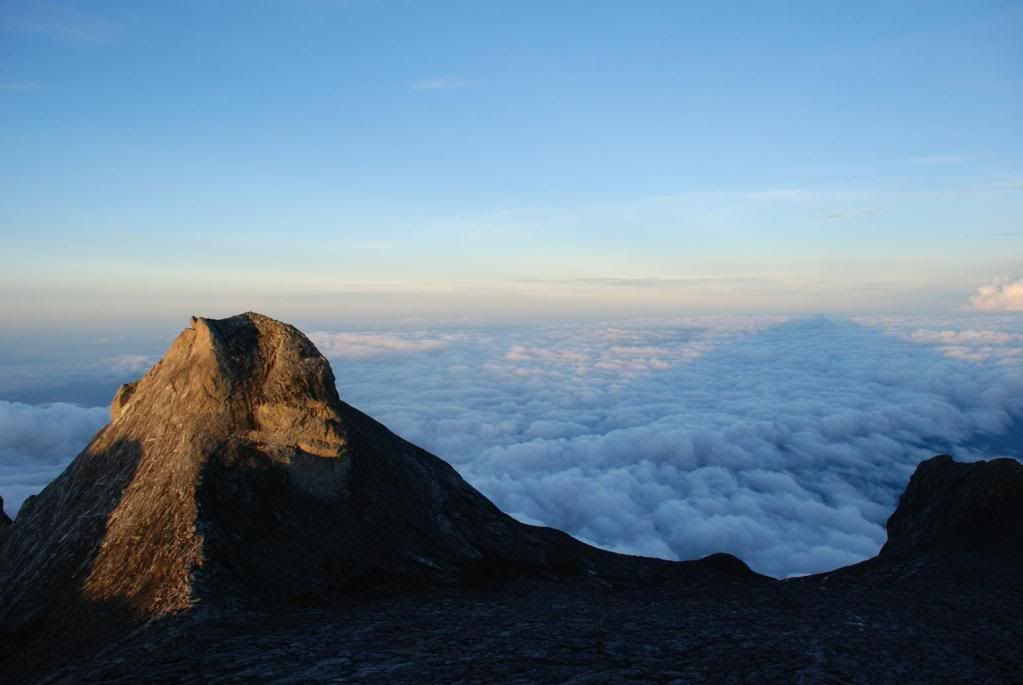

Surprisingly for me I was unaffected by the altitude, but many of the others in my group were - mainly nausea, dizziness and headaches. Everyone began to feel brighter as we progressed slowly down the hill with a spectacular morning unfolding before us - layers of white cloud obscured most of the land below us, and the granite peaks were lit in beautiful warm glow.


After our second breakfast at Laban Rata the really tough part began - descending another 1.5km of vertical height, mostly in giant-sized steps. It took hours, and by the time we were indulging in a vast lunch all our quads and knees were aching in a way we hadn't expected to feel until we were about 70 years old.

I departed from my group and made my way stiffly to the road, where I stepped on a bus to Sandakan and the next part of my trip. Sandakan, on the east coast of Sabah, is extremely close to the Philippines (that was originally on my itinerary) - nowadays it is a base for fishing and exporting palm oil, and an ugly one at that. Fortunately I had just one night there before my next booking, which I spent limping to a harbourfront cafe for dinner, then back to my room for an early night - it had been a 22 hour day.
The next morning I headed to Sepilok, the home of probably the most famous orangutan rehabilitation centre in the world. They do a good job - rehabilitated apes are flown into the remote Tabin Wildlife reserve and left to their own devices. The centre's popularity though means that the usual morning feeding, as witnessed elsewhere in Sumatra and Borneo, has an audience of around 200 tourists. Sadly it was the least impressive one I have been to - until the pig tailed macaques came by after the orangutans and tourists had gone, and pilfered all the remaining bananas. Although even the largest male is much smaller than me, it doesn't take a lot to be intimidated by a group of 40 or so as you walk right past them on a boardwalk.


I was picked up from Sepilok for next trip - a 4 day tour on the Kinabatang river. On the way we passed neverending palm oil plantations - and I mean that literally, there was no break at all. Plantations ranged from freshly felled forest to newly terraced slopes dotted with small palms, through to full sized palms producing several kilo of fruit a month. Each plantation tends to be huge, with accommodation for its workers and its own mill; the palm oil is used is a huge range of everyday products from food to cosmetics and, of course, biodiesel. Current EU energy policy has resulted in a huge increase in demand for palm oil - the principles of which are fine until you look at what the palm oil replaces.
Through this land of palm oil runs the Kinabatangan, or the "Corridor of Life". It is a designated wildlife sanctuary, small in area, that runs in a narrow strip up the banks of the Kinabatangan and it's major contributaries. It is the only area in the world where 10 species of primates can been seen in the same place (I won't list them), along with elephants, crocodiles and a range of hornbills. Due to the small size (and restriction of range of the animals) wildlife sightings are pretty much guaranteed, although elephants and orangutans prove more difficult usually.
On the bus I met a group of 3 Kiwis traveling together, and I quickly became an honorary member of the crew as we were assigned a dorm together. They were also staying longer than the standard 3 day/2 night trip, and we quickly settled into a routine of early morning and later afternoon cruises, night walks and volleyball in the intervening periods.



The first afternoon we were doing very well - proboscis monkeys up close already ticked off, when we came across a herd of Bornean pygmy elephants. Only recently identified as a separate species, these smallest of elephants were having an afternoon dip and crossing a river - even the guide said it was very unusual to see. It was an incredible sight; after initially seeing some grey shapes moving through the jungle undergrowth, they came out to test the water and swim, all the while trumpeting to each other with bellows that came straight out of Jurassic Park.
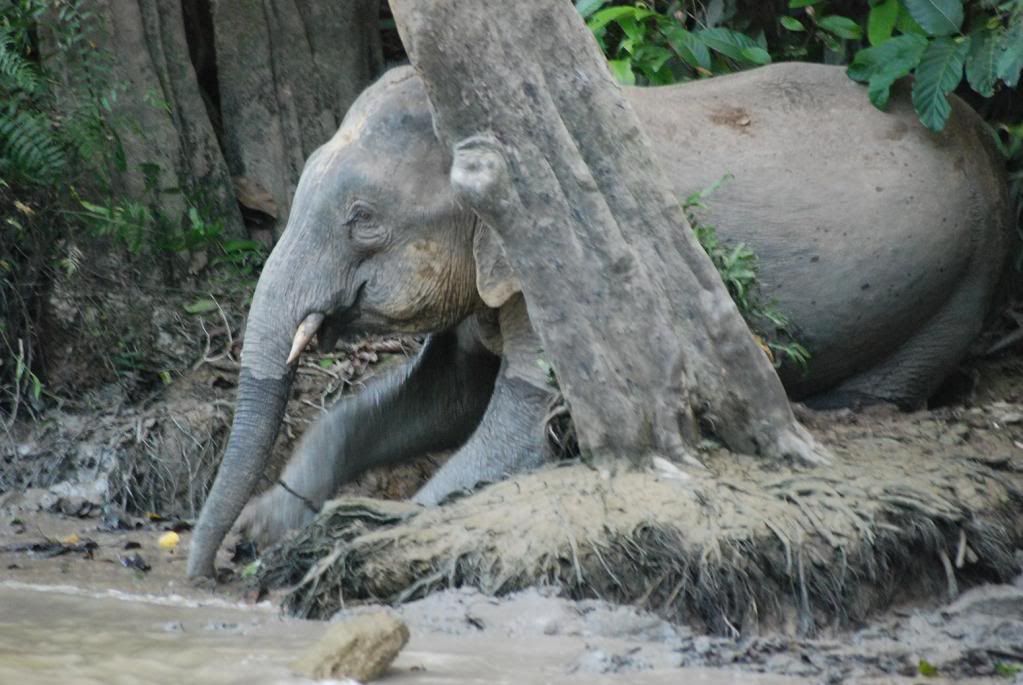

The various walks on offer were less rewarding. After 3 night walks we had seen several sleeping birds (dazzled by camera flashes) and a few large insects including a huge scorpion; there were no slow loris or western tarsiers that make up the nocturnal primate population around the Kinabatangan. We visited an oxbow lake one day too; aside from some distant stirrings of my geographical memory, it failed to excite with wildlife sightings and instead we were rather hot and mosquito bitten.

The best wildlife sighted on the day walk
We struck wildlife gold again the next 2 days, seeing orangutans, elephants, and orangutans watching elephants. There were also the proboscis monkeys and a wide variety of bird life that our guide, despite his somewhat elementary English, was able to identify incredibly rapidly and from a distance.
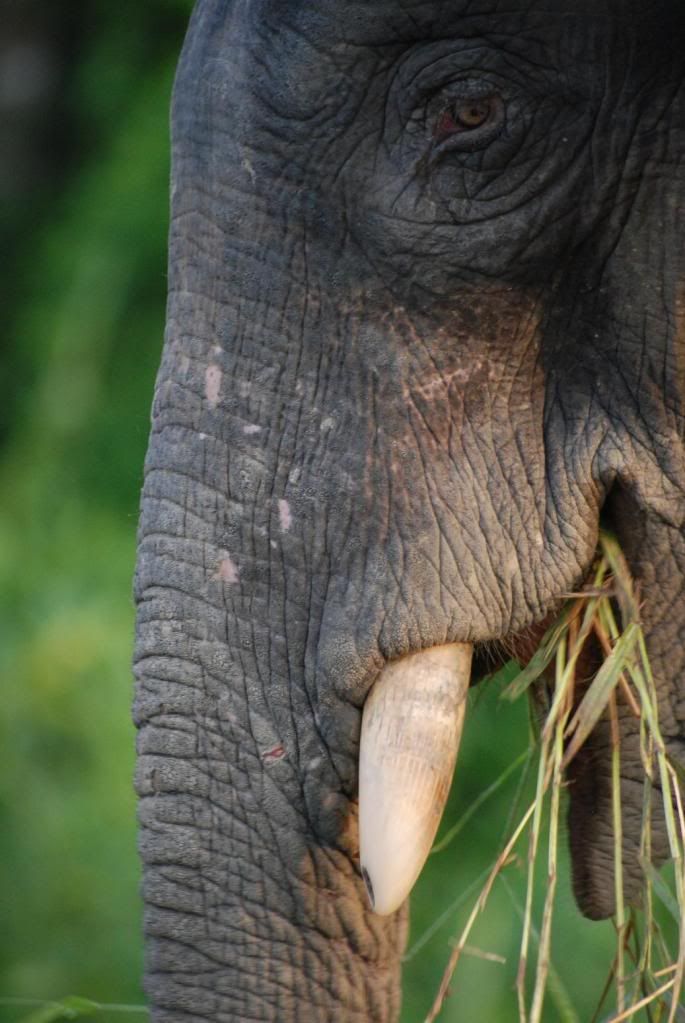


Elephants being watched by an orangutan
It was with some reluctance that I got on the bus with another English couple after 4 days and headed south again, to Semporna. It was only around 250km away but took a good few hours, in which time we passed only palm oil plantations. It was scary.
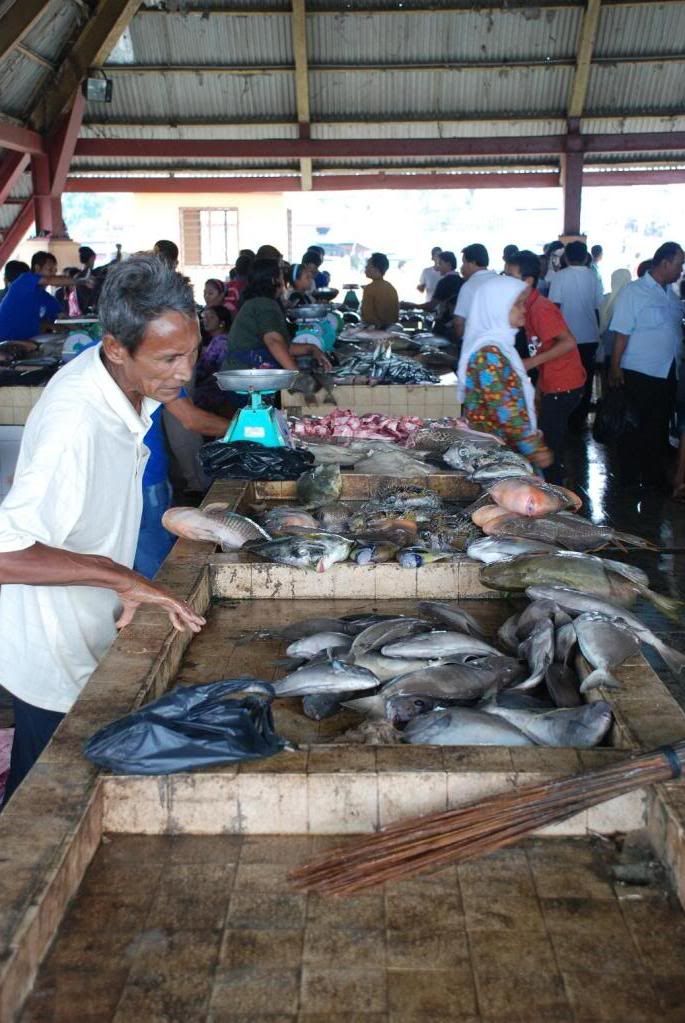
Semporna fish market
In Semporna I found myself a hostel for a night before the final part of my Sabah trip - diving at Sipadan. Pulau Sipadan is at the centre of a marine park with a huge richness and diversity of marine life due to it's location as a limestone atoll separated from the rest of the Borneo mainland by a huge channel. There are sharks and turtles a plenty, plus huge schools of fish not seem in many other places, and wonderful coral gardens. I had booked to stay a couple of nights on an old oil rig, parked a few miles from the island and a unique place to stay. Sipadan is one of the most popular dive sites in Asia and the numbers are strictly limited by permits, so getting the chance to dive there even for one day would hopefully be worth the significant amount of money I was shelling out.
Luckily it happened that my Sipadan experience was pretty good - I really loved the atmosphere on the oil rig, and there was a friendly bunch of Aussies and English to pass the time. I buddied up with Karen, an nice Aussie who worked for the Australian Antarctic Survey - I was incredibly jealous until I discovered she had to live on a ship and study phytoplankton. Her stories of 'going south' made me yearn for both a colder climate and a trip back to Antarctica though. As expected I only had a single permit to dive one day at Sipadan but managed to do 5 dives there, so was pretty pleased - we paid for a boat back in the afternoon at the princely sum of RM86 per person. The dives were better in the afternoon and there was almost no-one there, bar the Army chaps who were practicing swimming.
At the end of the day I also shelled on a 'Scuba Zoo' DVD of the day's diving - I look like an idiot in most of it, true to form. I also managed to purloin all the photos the a couple of Hong Kongese boys took who dived with me all the time - just as well really as they did puch everyone else out the way in order to see what was going on! Those will have to wait though, as there isn't the internet connection here to upload them.
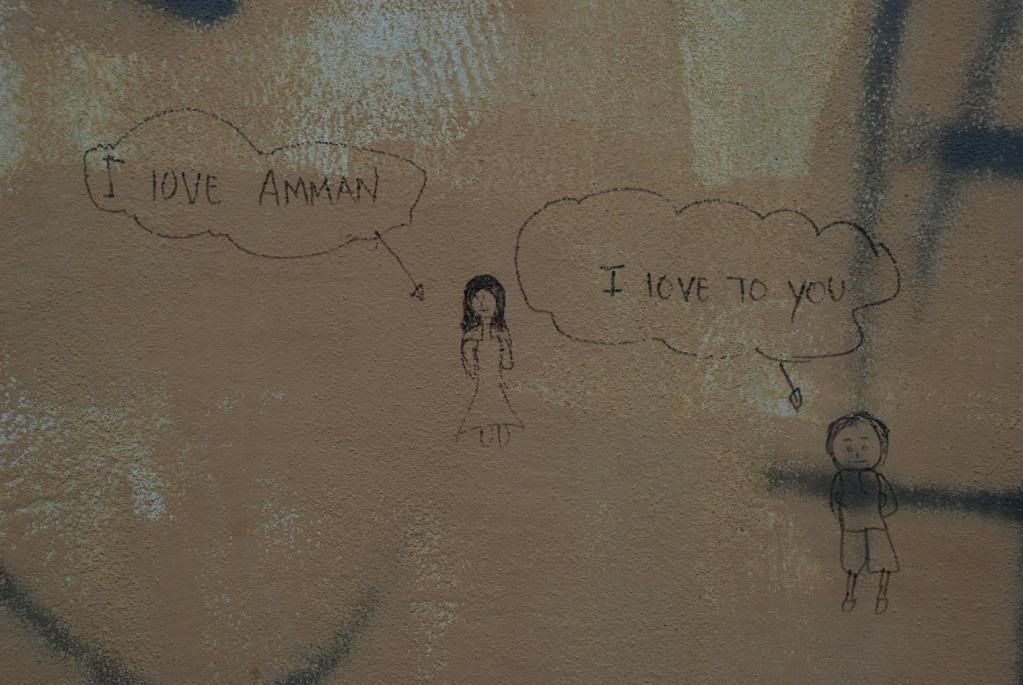
Semporna grafitti
Back from the oil rig, I was hot-footing it to Sulawesi, the Indonesian island east of Borneo - as fast as my no-fly time would allow. Everything worked all too smoothly on the way to Sualwesi - my overnight bus arrived on time at 4.30am in KK, where I sat around for several hours waiting for places to open to get some breakfast - no evidence of pre-dawn Ramadan feasting there! The flight to KL was on time, and there was the normal laughable AirAsia organisation in the LCCT where the gate was changed 3 times in 10 minutes and the final call for boarding was made before anyone had left the departure lounge. Fortunately the flights themselves are impeccable - I had 3 emergency exit seats to catch up on my missed sleep from the night before.
By 8pm the next day I had made it - just about on time - back to the land of "Hello Mister!" and, rather more surprisingly, "Metered taxi?"

Kampong Ayer as the storm comes

Waiting for the rain to stop
Brunei didn't blow us away, although I suspect with more time we would have found the Royal Regali museum pretty smart and the Empire Hotel on the coast pretty impressive - rivaling Dubai's finest for opulence. Instead we cruised over to the night market for food in the pouring rain - it was a tad washed out - and spent an hour or two wandering around shopping malls before calling it a night.
The following day we transferred east to Kota Kinabalu, in the Malaysian state of Sabah. Luckily our taxi driver to the ferry was more alert than we were, and smashed the speed limit in order to get us to the jetty in time for departure, 30 minutes earlier than we had been informed. We left Brunei with $2 to our names and a good deal of nervous laughter - Hyun was on a flight that afternoon from KK and missing the boat was not an option.
Kota Kinabalu - formerly Jessleton - is the capital of Sabah, which was formerly British North Borneo. Originally ceded ro the American consul in Brunei in 1846, the subsequent attempt to operate the American Trading Company of Borneo failed after 20 years, whereupon Dutch and English investors were convinced to take up the deal. Eventually in 1877 the cession was bought and extended to cover the present day area of Sabah, and 3 years later a royal charter was granted and the British North Borneo Company - and British North Borneo - was formed; the Dutch were booted out of the deal.
Kota Kinabalu - or KK - is a modern city with a thriving fishing, logging and tourism industry. It serves as the entry hub for legions of tourists arriving every year who want to experience the magic of Borneo without the difficulties of travel in less developed countries. We had been hearing stories of many of the most popular activities being booked up weeks in advance, and so I arrived with a pretty concrete plan of action for my two and a half week stay.
After saying goodbye to Hyun I set about booked and paying for my various trips - aside from the organisation required, many tourist attractions on Sabah are expensive and several well beyond the means of even the wealthiest of backpackers - the allegedly amazing National Parks of Tabin and Danum Valley cost well over US$100 per night. So I signed up for a rafting trip, booked my Mount Kinabalu climb, arranged some diving and a river safari - all within a couple of days. At least I wouldn't spent too much otherwise, I thought.....
The El Nino-inspired drought that has affected much of Borneo had taken it's toll on the river rafting. We took Sabah's only train to reach the access point - it was full so we rode on a flat iron car at the back, legs dangling over the edge and getting sunburnt. Health and Safety would have raised the odd eyebrow. After a remarkably thorough safety briefing I joined an all-Dutch raft to navigate our way down what should have been Grade III-IV rapids to lunch.
It was great fun, but a little disappointing. The rapids weren't huge, but it seemed like most of the time I was the only person who knew how to paddle and by lunch my shoulders and arms had had a good work out at least. We watched the video footage of our most exciting rapid over lunch - one of our team was washed out when we became perched on a rock - then pressed on quickly as we were running very late. It was a case of catching the train back to get a bus for the return - this time we had the privilege of seats. I was back in KK at 10pm that night, aching but happy... and a little burnt.
The next day I moved out of KK and up to Mount Kinabalu National Park- popularly known as South East Asia's highest peak at 4095m - that works if you don't include any of New Guinea in the equation, which has a couple over 5000m. Geographers might care to explain if SE Asia doesn't include New Guinea..... Given my past experience with nausea and headaches at that kind of altitude, I stayed a night close to the Park Headquarters, meeting a seemingly alcoholic American called Diego en route with his lovely Japanese girlfriend who didn't speak much English. Given Diego's passion for TV, it turned out to be a quiet night when he found we had HBO in the dorm room. In the morning, however, there was a tremendous view of Kinabalu in the early morning sun that made the stay well worth the effort.

The next morning was the day I had booked to start my trek to the summit of Kinabalu. The National Park is privately run by a luxury lodge company, Sutera Sancturary, who fail to appreciate that most of the customers are backpackers - it was some GBP80 for an unheated dormitory bed plus food for the following 30 hours - and that didn't include the compulsory guide and a few other extras. Luckily I met up with a couple of Irish girls and an English couple and we banded together to share costs and form a little hiking team.
The first day's hike was a long, tedious uphill slog that sapped strength and enthusiasm. For much of the time we were in fog and cloud, and were wary of the rain that was forecast to start - along with thunder and lightning - at any time. We made it up to the Laban Rata guesthouse after about 4 and a half hours, and were just sitting down with hot chocolates as the rain started to fall, progressing to hail shortly afterwards.

Laban Rata after the rain

Sunset at Laban Rata
What Sutera Sanctuary fail for in accommodation they try to make up for with food - there was oodles of it. Having gorged myself on a high carbohydrate dinner I settled in bed with a makeshift hot water bottle and tried to get in a few hours sleep before our summit day, which would start at 1.30am.

At a time that could officially be called silly-o'clock I woke up and had another carb-loaded early breakfast, before starting the slow walk up to the summit in the dark, along with about 200 other people. The route had many stairs and roped sections, and unsurprisingly progress was very slow as people struggled in the thin air and dark. Nevertheless we made it to the summit in time for sunrise, and everyone stopped to take photos as their fingers froze and feet went numb. The summit was a very crowded place.


Surprisingly for me I was unaffected by the altitude, but many of the others in my group were - mainly nausea, dizziness and headaches. Everyone began to feel brighter as we progressed slowly down the hill with a spectacular morning unfolding before us - layers of white cloud obscured most of the land below us, and the granite peaks were lit in beautiful warm glow.


After our second breakfast at Laban Rata the really tough part began - descending another 1.5km of vertical height, mostly in giant-sized steps. It took hours, and by the time we were indulging in a vast lunch all our quads and knees were aching in a way we hadn't expected to feel until we were about 70 years old.

I departed from my group and made my way stiffly to the road, where I stepped on a bus to Sandakan and the next part of my trip. Sandakan, on the east coast of Sabah, is extremely close to the Philippines (that was originally on my itinerary) - nowadays it is a base for fishing and exporting palm oil, and an ugly one at that. Fortunately I had just one night there before my next booking, which I spent limping to a harbourfront cafe for dinner, then back to my room for an early night - it had been a 22 hour day.
The next morning I headed to Sepilok, the home of probably the most famous orangutan rehabilitation centre in the world. They do a good job - rehabilitated apes are flown into the remote Tabin Wildlife reserve and left to their own devices. The centre's popularity though means that the usual morning feeding, as witnessed elsewhere in Sumatra and Borneo, has an audience of around 200 tourists. Sadly it was the least impressive one I have been to - until the pig tailed macaques came by after the orangutans and tourists had gone, and pilfered all the remaining bananas. Although even the largest male is much smaller than me, it doesn't take a lot to be intimidated by a group of 40 or so as you walk right past them on a boardwalk.


I was picked up from Sepilok for next trip - a 4 day tour on the Kinabatang river. On the way we passed neverending palm oil plantations - and I mean that literally, there was no break at all. Plantations ranged from freshly felled forest to newly terraced slopes dotted with small palms, through to full sized palms producing several kilo of fruit a month. Each plantation tends to be huge, with accommodation for its workers and its own mill; the palm oil is used is a huge range of everyday products from food to cosmetics and, of course, biodiesel. Current EU energy policy has resulted in a huge increase in demand for palm oil - the principles of which are fine until you look at what the palm oil replaces.
Through this land of palm oil runs the Kinabatangan, or the "Corridor of Life". It is a designated wildlife sanctuary, small in area, that runs in a narrow strip up the banks of the Kinabatangan and it's major contributaries. It is the only area in the world where 10 species of primates can been seen in the same place (I won't list them), along with elephants, crocodiles and a range of hornbills. Due to the small size (and restriction of range of the animals) wildlife sightings are pretty much guaranteed, although elephants and orangutans prove more difficult usually.
On the bus I met a group of 3 Kiwis traveling together, and I quickly became an honorary member of the crew as we were assigned a dorm together. They were also staying longer than the standard 3 day/2 night trip, and we quickly settled into a routine of early morning and later afternoon cruises, night walks and volleyball in the intervening periods.



The first afternoon we were doing very well - proboscis monkeys up close already ticked off, when we came across a herd of Bornean pygmy elephants. Only recently identified as a separate species, these smallest of elephants were having an afternoon dip and crossing a river - even the guide said it was very unusual to see. It was an incredible sight; after initially seeing some grey shapes moving through the jungle undergrowth, they came out to test the water and swim, all the while trumpeting to each other with bellows that came straight out of Jurassic Park.


The various walks on offer were less rewarding. After 3 night walks we had seen several sleeping birds (dazzled by camera flashes) and a few large insects including a huge scorpion; there were no slow loris or western tarsiers that make up the nocturnal primate population around the Kinabatangan. We visited an oxbow lake one day too; aside from some distant stirrings of my geographical memory, it failed to excite with wildlife sightings and instead we were rather hot and mosquito bitten.

The best wildlife sighted on the day walk
We struck wildlife gold again the next 2 days, seeing orangutans, elephants, and orangutans watching elephants. There were also the proboscis monkeys and a wide variety of bird life that our guide, despite his somewhat elementary English, was able to identify incredibly rapidly and from a distance.



Elephants being watched by an orangutan
It was with some reluctance that I got on the bus with another English couple after 4 days and headed south again, to Semporna. It was only around 250km away but took a good few hours, in which time we passed only palm oil plantations. It was scary.

Semporna fish market
In Semporna I found myself a hostel for a night before the final part of my Sabah trip - diving at Sipadan. Pulau Sipadan is at the centre of a marine park with a huge richness and diversity of marine life due to it's location as a limestone atoll separated from the rest of the Borneo mainland by a huge channel. There are sharks and turtles a plenty, plus huge schools of fish not seem in many other places, and wonderful coral gardens. I had booked to stay a couple of nights on an old oil rig, parked a few miles from the island and a unique place to stay. Sipadan is one of the most popular dive sites in Asia and the numbers are strictly limited by permits, so getting the chance to dive there even for one day would hopefully be worth the significant amount of money I was shelling out.
Luckily it happened that my Sipadan experience was pretty good - I really loved the atmosphere on the oil rig, and there was a friendly bunch of Aussies and English to pass the time. I buddied up with Karen, an nice Aussie who worked for the Australian Antarctic Survey - I was incredibly jealous until I discovered she had to live on a ship and study phytoplankton. Her stories of 'going south' made me yearn for both a colder climate and a trip back to Antarctica though. As expected I only had a single permit to dive one day at Sipadan but managed to do 5 dives there, so was pretty pleased - we paid for a boat back in the afternoon at the princely sum of RM86 per person. The dives were better in the afternoon and there was almost no-one there, bar the Army chaps who were practicing swimming.
At the end of the day I also shelled on a 'Scuba Zoo' DVD of the day's diving - I look like an idiot in most of it, true to form. I also managed to purloin all the photos the a couple of Hong Kongese boys took who dived with me all the time - just as well really as they did puch everyone else out the way in order to see what was going on! Those will have to wait though, as there isn't the internet connection here to upload them.

Semporna grafitti
Back from the oil rig, I was hot-footing it to Sulawesi, the Indonesian island east of Borneo - as fast as my no-fly time would allow. Everything worked all too smoothly on the way to Sualwesi - my overnight bus arrived on time at 4.30am in KK, where I sat around for several hours waiting for places to open to get some breakfast - no evidence of pre-dawn Ramadan feasting there! The flight to KL was on time, and there was the normal laughable AirAsia organisation in the LCCT where the gate was changed 3 times in 10 minutes and the final call for boarding was made before anyone had left the departure lounge. Fortunately the flights themselves are impeccable - I had 3 emergency exit seats to catch up on my missed sleep from the night before.
By 8pm the next day I had made it - just about on time - back to the land of "Hello Mister!" and, rather more surprisingly, "Metered taxi?"

1 comment:
Nice shots Pete, and finally somewhere i've managed to get to before you!!!! Dave
Post a Comment